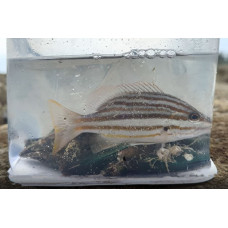Latin name
Lutjanus carponotatus
Other name
Stripey snapper, dusky-striped sea-perch, gold-banded sea perch, gold-stripe sea-perch, striped seaperch, stripey seaperch.
Identification
The Spanish flag snapper has a moderately deep body, about 2.5 times its normal length. The snout is rather pointed with a steep dorsal profile. The tubercle and notch on the preoperculum are poorly developed. The anterior teeth may be arranged as a triangular plate extending posteriorly or as a rhomboid, and there is a small area of granular teeth on the tongue. Rows of scales on the back rise diagonally from the lateral line.
Features of fish fins
The dorsal fin has 10 spines and 14 to 16 soft rays, while the anal fin has 3 spines and 9 soft rays. The posterior part of the dorsal and anal fins are rounded, the pectoral fin has 15 to 17 rays and the caudal fin is pointed.
Fish colouring
The general colouration of this species is bluish-grey to whitish, with 8-9 yellow to golden-brown horizontal stripes on the sides, the fins are yellow, and there is a blackish spot in the sinus and at the base of the uppermost rays of the pectoral fin. Juveniles have a broad white vertical stripe running from the snout to the base of the caudal fin, with alternating dark brown and black stripes above and below this white stripe.
Distribution
They are found in the Indo-West Pacific. Their range extends from the coast of the Andaman Sea and Bay of Bengal in western India east to Papua New Guinea, north to the South China Sea and south to northern Australia. In Australia, they occur from Shark Bay in Western Australia eastwards to Morton Bay in Queensland, possibly as far south as northern New South Wales, and on reefs in the Coral Sea.
Habitat
They inhabit depths from 2 to 80 m (6 ft 7 in and 262 ft 6 in), although they are rarely found below 15 m (49 ft). Adults inhabit coral reefs, both sheltered lagoons and outer slopes, often in turbid nearshore waters. Juveniles are found on the back reef close to shore where Acropora corals are found with sandy substrate.
Size
The maximum recorded total length for this species is 40 cm (16 inches), although 30 cm (12 inches) is more typical. They have a life expectancy of 18-20 years.
Behavior
They are often found in schools of 20-30.
Food and feeding habits
They are active predators using ambush tactics to catch smaller fish and crustaceans, although they are somewhat enterprising and have been recorded eating juvenile sea turtles.
Reproduction
The larval stage of this species is pelagic and lasts 3-4 weeks before the larva becomes sedentary. Once adult, they are sedentary and tend to stay within a small home range. They then grow rapidly for the first 3-4 years, with females reaching sexual maturity at 2 years of age and a forked length of about 19 cm (7.5 inches).
The number of eggs a female can lay increases with size, as does the size of the eggs themselves, and larger females can lay over 700,000 eggs at a time.
Fishing
Spanish red snapper is an important species for artisanal, recreational and commercial fisheries throughout its range. It is mainly caught using line and reel (Australia), traps and gillnets. In Western Australia it is pursued by recreational anglers. It is also caught by trawlers. In Australia, it accounts for less than 10% of the total commercial catch on the Great Barrier Reef. It is commercially important in the Philippines and Indonesia, but catch statistics are not available.
Relationship with a person
Harmless. This fish is usually sold fresh in the market.
| Classification | |
| Phylum | Chordata |
| Class | Actinopterygii |
| Squad | Perciformes |
| Family | Lutjanidae |
| Genus | Lutjanus |
| Species | L. carponotatus |
| Features | |
| Conservation status | Least Concern |
| Habitat | Pelagic |
| Life span, years | 20 |
| Maximum body weight, kg | No information |
| Maximum length, cm | 40 |
| Sailing speed, m/s | No information |
| Threat to people | Edible |
| Way of eating | Predator |
Spanish flag snapper
Tags: spanish flag snapper

